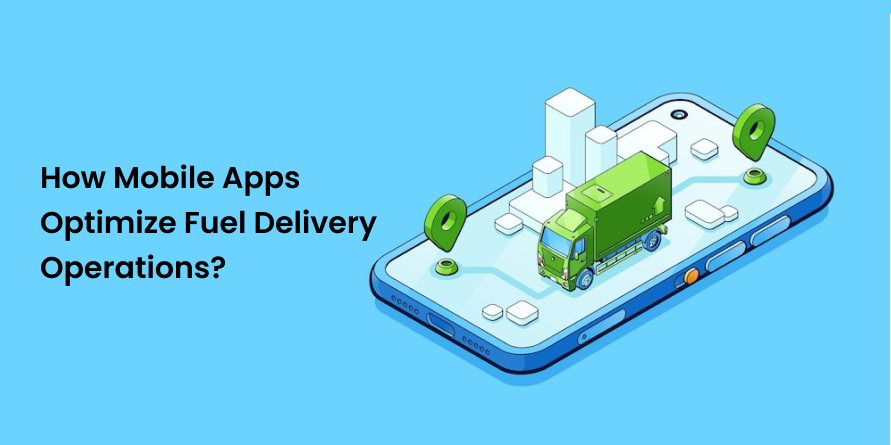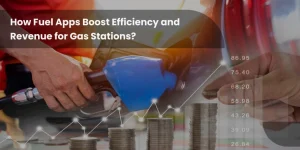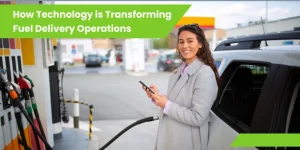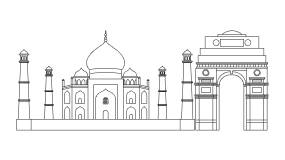How Mobile Apps Optimize Fuel Delivery Operations?

With the digital trend overtaking our daily operations, a new era is dawning in doorstep fuel delivery as more and more gas station owners develop their apps for ordering fuel. This new concept, which meets the needs of modern customers in an evolving business environment, offers multiple benefits to enterprises within an increasingly huge fuel business.
Considering the convenience the fuel delivery app offers customers, this sector has been experiencing decent growth over time. With rapid advancements in mobile and IoT technology, businesses in the fuel sector are increasingly investing in fuel delivery app development solutions to stay competitive in a fast-growing market.
Many app development companies have emerged as a prominent name, and the growing demand for fully functional tech solutions has caused it. These tech partners are essential in determining the scope of this business and balancing between the business’s requirements and customer’s preferences.
From fleet management to improved customer experience, learn how a mobile app can take your conventional fuel business to the next level!
How Do Mobile Apps Optimise Fuel Delivery Operations?
A successful fuel delivery business begins with a user-friendly, feature-rich, robust mobile app. However, if you are initially unsure about full-fledged development, you can also opt for MVP development to validate your idea in the market.
Once you start getting positive responses, invest in a fully-featured app or software. Still not sure why? This section explores seven reasons mobile apps streamline and optimise fuel delivery business. Let’s dive right in!

1. Simplified Customer Management
The backend of the fuel delivery app generates a unique user ID each time a user installs an app. You can build a thorough user profile using this valuable data along with the user’s several profiles.
Recent transactions, quantity, payment method, location and other information can be tracked easily to offer them a personalised customer experience. In other words, it feeds data into your CRM, simplifying customer management and engagement.
2. Route Planning
One of the most significant ways mobile apps can optimize fuel delivery operations is through advanced route planning. Traditional route planning involved manual calculations and relying on outdated maps, often inefficient and time-consuming.
For example, an IoT-based app can analyse live data, road conditions, weather reports, and fuel consumption rates to provide drivers with innovative routes, reducing unnecessary detours and delays. This saves time, helps to cut fuel costs and improves overall operational efficiency.
IoT-censored devices on delivery trucks can also provide real-time insights, such as engine status, fuel levels, and driver behaviour, to refine route optimisation further. For instance, if a fuel delivery truck is approaching a congested area or a construction zone, the app can automatically suggest an alternative route, ensuring the delivery is made on time while minimising fuel wastage.
3. Fleet Management
With IoT-enabled sensors installed in vehicles, the app can track various parameters such as vehicle location, engine health, fuel consumption, and driver behaviour. This data can be accessed remotely, allowing fleet managers to make informed decisions on maintenance schedules, fuel usage, and driver performance.
By integrating AI/ML-enabled solutions into fleet management, fuel delivery companies can predict when a vehicle will need maintenance based on usage patterns, temperature conditions and historical performance data.
For instance, if a delivery truck equipped with IoT sensors is predicted to need a service soon, the AI system can reroute the car to a nearby service centre before it fails, minimising downtime. These proactive measures ensure that fuel delivery operations are more streamlined and that assets are used smartly, contributing to cost savings and better customer satisfaction.
4. Customer Tracking
Mobile apps have revolutionised customer tracking by giving customers and fuel delivery operators real-time visibility into the delivery process. Customers can track the exact location of their fuel delivery via the app, receive real-time updates on estimated arrival times, and get notifications about any delays or changes.
Moreover, the app can offer features like customer preferences and history, allowing delivery companies to tailor their services more accurately to each client’s needs.
From an operational perspective, IoT and AI technologies can enhance customer tracking by enabling more personalised and responsive services. For example, IoT sensors can alert delivery managers to track fuel consumption levels in real time, allowing for precise delivery schedules based on demand patterns.
Additionally, AI algorithms can analyse customer data to predict when a particular client may need a fuel delivery based on past usage trends, improving the accuracy of delivery time windows. This predictive approach can reduce the chances of late deliveries, optimise inventory levels, and ensure that customers never run out of fuel. In fact, transforming fuel delivery operations through technology has become a key trend in the industry.
Want to take your conventional fuel delivery business to
the next level with mobile technology?
5. Continues Optimization and Improvement
Building a successful fuel delivery app is an iterative process requiring continuous optimisation and improvement based on user feedback and market trends. Regular updates and adding modern features ensure that the app remains competitive in a saturated business world.
By analysing customer patterns, tracking key metrics, and staying ahead of industry development, fuel business owners can stay ahead of the curve and deliver exceptional value to their customers.
6. Improved Brand Image
A mobile app can improve brand image and awareness by creating a unique and engaging experience in the fuel business. Moreover, it can offer certain features such as push-notifications, personalized recommendations based on customer’s preferences and order history.
Customized fuel delivery apps for fuel ordering also have some loyalty programs that reward customers with discounts and points. You can also have social media integration in your fuel delivery apps that allow customers to share their experiences, reviews and images with their followers and friends.
7. Access to Valuable Insights and Analytics
A fuel delivery app offers access to important insights and analytics about customer’s preferences, ordering patterns, and fuel quantity. You may use this data to your advantage to improve your fuel delivery services, and marketing initiatives. The valuable data gained from the app can help you find growth opportunities and enhance your overall business performance.
Join the Billion-dollar Fuel Delivery Business Now
The fuel delivery industry is rapidly evolving into a billion-dollar business, driven by the growing demand for convenience and the power of technology. With mobile apps, AI, and IoT transforming the way fuel is delivered, now is the perfect time to tap into this booming market. Whether you’re looking to streamline operations, boost customer satisfaction, or enhance fleet efficiency, there’s never been a better moment to innovate in fuel delivery. To stay competitive, it’s important to follow the latest on-demand fuel delivery trends and adapt accordingly.
Don’t miss out on this lucrative opportunity—contact us today to develop a cutting-edge fuel delivery app that will position your business at the forefront of the industry! Let’s fuel your success together!


















